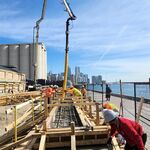Does the first map show DAs? Some of those zones seem really tiny.
The only problem with adding employment to residences is that the jobs are added to census tracts which are divided up based on where the residences are...a cluster of condos may receive its own census tract (or one of the smaller census zones) and be set apart from a sea of bungalows, but a cluster of office towers is invariably included with seas of parking lots and warehouses and strip malls because without a residential population there's no reason to sever the area for census purposes.
It's sort of like packing/cracking issues with gerrymandered ridings. This affects areas like the Kennedy/401/Markham/Ellesmere block (STC), as well as the 404 office parks in Markham, even the CBD itself (though that is about uniformly extremely dense with jobs). I don't know if there's any more realistic but still practical way to show where jobs are within employment areas.
One tweak that would be interesting is to show population and jobs on the same map using two colour scales, like red for homes and blue for jobs, where white zones are uninhabited day and night, red zones are dense during the night, blue zones dense during the day, and purple zones dense both day and night. 25-49+ total zones on such a map would help distinguish homes from jobs on a combined map, though this isn't especially useful if one is very familiar with the location of all of the residential and office tower clusters.




